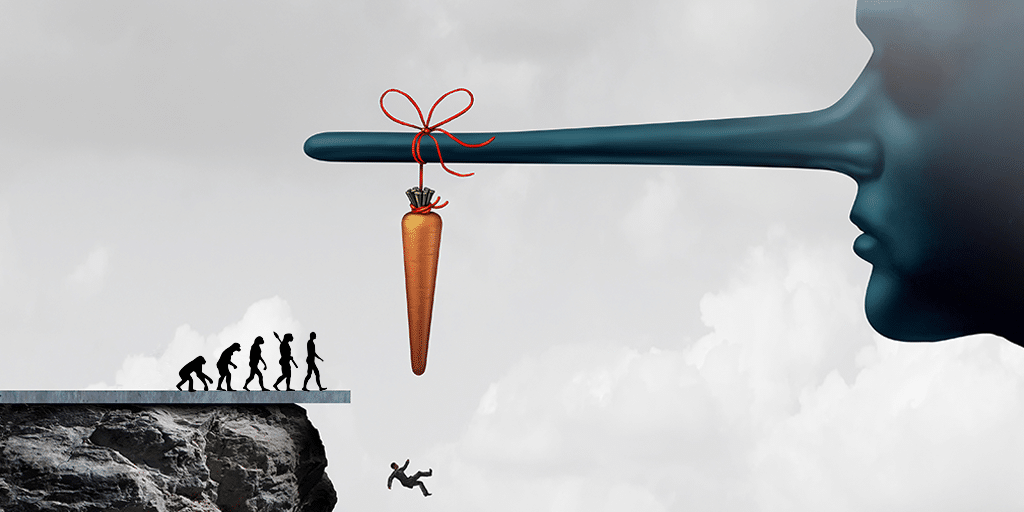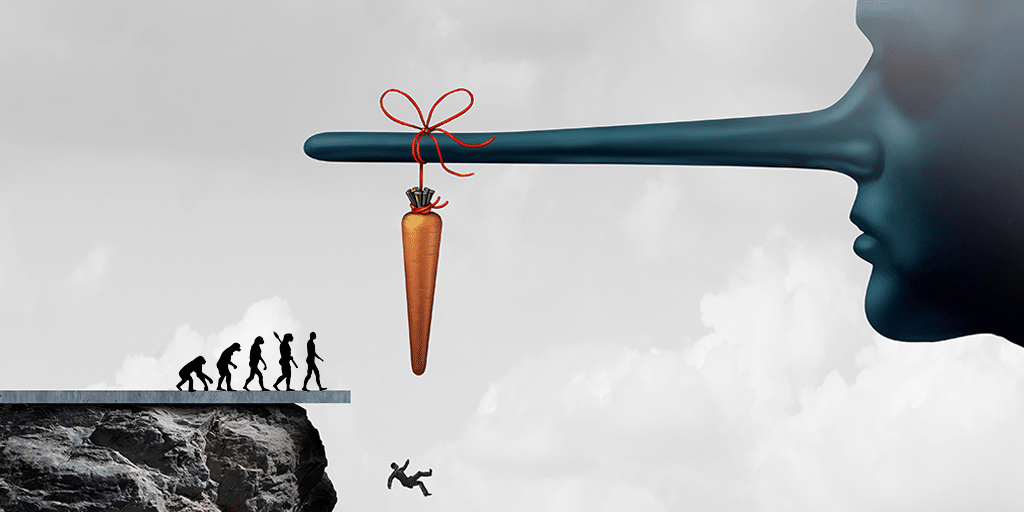Does the Fossil Record Prove that Evolution is True? – Part 3

| By: Dr. John Ankerberg and Dr. John Weldon; ©1999 |
| By now we have learned that there is an embarrassing lack of transitional forms in the fossil record. What new theories have evolutionary scientists formed to explains that? |
Evolution is a Proven Fact of Science
False Assumption Four—Part Three
(Continuing the discussion of false assumption four: The fossil record offers genuine scientific evidence that evolution is true.)
Interested readers may wonder if evolutionary scientists have developed any new theories to explain the embarrassing lack of transitional forms in the fossil record.
Perhaps it was a statement by Darwin concerning the abrupt appearance of many higher plant and animal forms which has recently sparked a new evolutionary theory. For example, Darwin observed: “Nothing is more extraordinary in the history of the Vegetable Kingdom, as it seems to me, than the apparently very sudden or abrupt development of the higher plants.”[1] Again, he felt this absence of plant and animal transitions was “the gravest objection” that could be raised against his theory.[2] So what new evolutionary theory has been created to fit the lack of transitional evidence in the fossil record and to explain the “abrupt appearance” of living things that no one can deny the fossil record does display?
Niles Eldredge and Stephen J. Gould tentatively proposed the following theory to account for the record as it exists. They suggest that the major gaps should be viewed as real phenomena of nature, an inevitable result of the mechanism of evolution itself. They see evolution taking place in major creative episodes, occurring at different times and places, interspaced with long periods of stability. They call their theory “punctuated equilibrium,” also known as evolutionary saltationism. In part, this theory returns us to geneticist Richard Goldschmidt’s “hopeful monsters” theory, which in Stanley’s words, “engender[s] such visions as the first bird hatching from a reptile egg.”[3]
Gould explains how this idea works in The Panda’s Thumb, although elsewhere he acknowledges that he and Eldredge do not hold to the exclusive validity of this concept. Nevertheless, they feel their theory is not inconsistent with the Darwinian model and that it helps to explain the gaps in the fossil record—which they believe does adequately express evolutionary history: “Thus, the fossil record is a faithful rendering of what evolutionary theory predicts, not a pitiful vestige of a once bountiful tale. Eldredge and I refer to this scheme as the model of punctuated equilibria. Lineages change little during most of their history, but events of rapid speciation occasionally punctuate this tranquility.”[4] Realize that, in part, Gould’s concept is an admission that Darwin’s theory of gradual evolution is not correct. Gould’s theory of “punctuated equilibrium,” which assumes the higher categories of plants and animals “suddenly” appeared “fully” formed in the fossil record, is, perhaps in a fashion, not much different from those who believe God created life forms instantaneously.
The fossil evidence is so poor that even the accomplished Swedish botanist and geneticist, Nils Heribert-Nilsson made the following confession and offered an amazing alternate theory. After 40 years of attempting to find evidence for the theory of evolution, he concluded that the task was impossible and that the theory was even “a serious obstruction to biological research.” In his 1200 page magnum opus, Synthetic Speciation, he declared the theory “ought to be entirely abandoned,” in part because it “obstructs—as has been repeatedly shown—the attainment of consistent results, even from uniform experimental material. For everything must ultimately be forced to fit this speculative theory. An exact biology cannot, therefore, be built up.”[5]
After noting “A close inspection discovers an empirical impossibility to be inherent in the idea of evolution,”[6] he went even farther than Gould, stating his conviction that geologic periods having incredible spurts of biogeneration produced billions of biosyntheses simultaneously. Gametes and other necessary cells and biocatalytic substances literally appeared spontaneously and led immediately to their fully formed end product such as orchids, elephants and eagles! Listen to his own explanations of why he made such a daring conclusion. It was because the empirical evidence forced him to it:
- As I have pointed out, there is no discussion among biologists today whether an evolution has taken place or not. The discussion concerns the how, the causation of evolution. No definite answer has been given to this question.
- It then becomes necessary to ask: Has there really been an evolution? Are the proofs of its occurrence tenable?
- After a detailed and comprehensive review of the facts we have been forced to give the answer: No! Neither a recent nor a palaeohistorical evolution can be empirically demonstrated.
- If this is the case, all discussions and problems concerning the causation of an evolution lose all interest. Lamarckism or mutationism, monophyletic or polyphyletic, continuity or discontinuity—the roads of the evolution are not problems any more. It is rather futile to discuss the digestion or the brain functions of a ghost.
- When we have arrived at this standpoint, the evolutionist has the obvious right to ask: What has caused the fundamental differentiation in the world of organisms, the immeasurable variation among animals and plants? That it exists is a fact: you owe us an explanation!
- We turn to empirical facts to obtain the answer. They tell us that during the geological history of the earth gigantic revolutions have occurred which at the same time mean tabula rasa catastrophes for a whole world of organisms but also the origin of a completely new one. The new one is structurally completely different from the old one. There are no other transitions than hypothetical ones. This origination of biota, which from a geological point of view is sudden as a flaring up I have called emication.
- During palaeobiological times whole new worlds of biota have been repeatedly synthesized.
- I will be asked: Do you seriously want to make such a statement? Do you not see that the consequences of such a theory are more than daring, that they would be nearly insane? Do you really mean to say that an orchid or an elephant should have been instantaneously created out of non-living material?
- Yes, I do.[7]
Here we see an illustration of what was discussed earlier. Rather than abandon a bad theory entirely, even more absurd theories are proposed so as to maintain one’s materialistic ideology. Regardless, another scientist who supports Gould’s new theory of evolution is Steven M. Stanley, who wrote the following in the preface of his book The New Evolutionary Timetable: Fossils, Genes, and the Origin of Species, “The [fossil] record now reveals that species typically survive for a hundred thousand generations, or even a million or more, without evolving very much. We seem forced to conclude that most evolution takes place rapidly, when species come into being by the evolutionary divergence of small populations from parent species. After their origins, most species undergo little evolution before becoming extinct.”[8]
But what do other scientists think about replacing Darwin’s theory of “gradualism” with Stephen J. Gould’s “punctuated equilibrium”? In essence, not much. For example, Ernest Mayr says the “hopeful monsters” theory “is equivalent to believing in miracles.”[9] And he’s correct.
Denton succinctly explains the problems faced by this approach:
- While [Niles] Eldredge and [Stephen Jay] Gould’s model is a perfectly reasonable explanation of the gaps between species (and, in my view, correct), it is doubtful if it can be extended to explain the larger systematic gaps. The gaps which separate species: dog/fox, rat/mouse, etc., are utterly trivial compared with, say, that between a primitive terrestrial mammal and a whale or a primitive terrestrial reptile and an Ichthyosaur; and even these relatively major discontinuities are trivial alongside those which divide major phyla such as molluscs and arthropods. Such major discontinuities simply could not, unless we are to believe in miracles, have been crossed in geologically short periods of time through one or two transitional species occupying restricted geographical areas. Surely, such transitions must have involved long lineages including many collateral lines of hundreds or probably thousands of transitional species….To suggest that the hundreds, thousands or possibly even millions of transitional species which must have existed in the interval between vastly dissimilar types were all unsuccessful species occupying isolated areas and having very small population numbers is verging on the incredible![10]
In other words, if evolution is to be considered a true scientific fact, it must be able to explain the origin of developed life forms by recourse to proven methods of evolutionary change. Can it do so? It would seem that most scientists who have examined this subject critically are honest enough to say no, even though they continue to believe in evolution. The problems of natural selection, mutation and newer theories attempting to explain how evolution occurs are, put simply, too expansive to be resolved by current knowledge.[11] Indeed, some scientists have confessed there is little hope that any conceivable breakthrough in this area will ever be forthcoming.[12]
But if it has now been suggested that certain theories relative to evolution require a belief in miracles, is this also true for evolutionary belief generally?
NOTES
- ↑ Francis Darwin, ed., The Life and Letters of Charles Darwin (New York: Johnson Reprint, 1969), Vol. 3, p. 248. Apparently is emphasized in the original.
- ↑ Charles Darwin, The Origin of Species (ed: J. W. Burrow), p. 292.
- ↑ Stanley, Macroevolution, p. 35.
- ↑ Stephen J. Gould, The Panda’s Thumb: More Reflections in Natural History, (New York: W. W. Norton & Co., 1980), 184-185 and our note 30, p. 24.
- ↑ Nils Heribert-Nilsson, Synthetische Artbildung (Lund, Sweden: CWK Glerups, 1953), p. 11.
- ↑ Ibid., pp. 1142-43.
- ↑ Ibid., pp. 1239-40.
- ↑ Steven M. Stanley, The New Evolutionary Timetable: Fossils, Genes, and the Origin of Species (New York: Basic Books, 1981), p. xv.
- ↑ E. Mayr, Populations, Species and Evolution, p. 253 (1970) Harvard University Press, in Bird, I, p. 177 (cf., Bird, pp. 168-177).
- ↑ Michael Denton, Evolution: A Theory in Crisis, p. 193-194. See also Stanley, Macro-evolution, pp. 122-23.
- ↑ e.g., cf., the citations in Bird, I, pp. 155-290 (cf., pp. 134-155).
- ↑ cf., Coppedge, Evolution, p. 113, passim.








